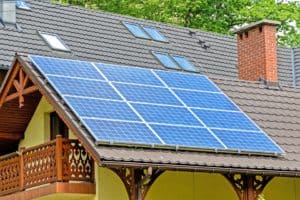
Green Building Practices: Designing and Constructing Eco-Friendly Homes
Green building practices revolutionize how we design and construct homes. These practices reduce environmental impact and enhance living conditions. Eco-friendly homes prioritize energy efficiency, water conservation, and sustainable materials.
Discover how you can contribute to a greener future through smart building choices.
Why Build Green Homes?
Eco-friendly homes significantly reduce environmental impact by using sustainable materials and energy-efficient systems, minimizing waste, and lowering carbon emissions.
They offer substantial cost savings through reduced utility bills and tax incentives, improve health with better indoor air quality, enhance property value, and support the green economy by fostering innovation and creating jobs.
Here are the key elements of green building practices:
Energy Efficiency
High-performance windows, proper insulation, and energy-efficient HVAC systems reduce energy consumption. Renewable energy sources like solar energy systems or wind power further enhance energy efficiency.
Sustainable Site Selection and Development
Opt for locations that reduce ecological disturbance, steer clear of floodplains, and protect natural habitats, and existing infrastructure while considering integrated pest management strategies.
Water Conservation
Employ techniques to reduce water usage, such as low-flow fixtures, rainwater harvesting systems, and drought-resistant landscaping.
Material Selection
Opt for sustainable, recycled, or low-impact materials like bamboo flooring, recycled steel, and low-VOC (volatile organic compounds) paints.
Indoor Environmental Quality
Improve air quality, natural lighting, and acoustics with non-toxic materials and proper ventilation.
Benefits of Green Building Practices
- Environmental Impact: Significantly reduce carbon footprint and resource depletion.
- Economic Savings: Lower utility bills and maintenance costs over time.
- Health and Well-being: Improve indoor air quality and natural light, contributing to better health for occupants.
- Market Value: Increase property value and appeal to eco-conscious buyers.
Implementation Strategies
- Integrated Design Process: Collaborate with architects, engineers, and builders to ensure sustainability goals are met.
- Performance Monitoring: Use smart technologies to monitor energy and water usage, to maintain efficiency.
- Certification Programs: Aim for certifications like LEED or BREEAM to validate and guide your green building efforts.
Common Green Building Materials
- Bamboo: Rapidly regenerates and is used for flooring, cabinetry, and structural elements.
- Recycled Steel: Reduces the need for new steel production and is used in framing and structural supports.
- Insulated Concrete Forms (ICFs): Provide high insulation and strength for energy-efficient walls.
- Low-VOC Paints and Finishes: Improve air quality by releasing fewer pollutants.
- Reclaimed Wood: Adds character and reduces the demand for new lumber.
- Cork: Used for flooring and insulation due to its thermal and acoustic properties.
- Recycled Glass: Used for countertops, tiles, and decorative elements.
- Hempcrete: Provides excellent thermal performance and is highly sustainable.
- Wool Insulation: Offers excellent insulation properties and is resistant to mold and mildew.
- Straw Bales: Provide high insulation value and are eco-friendly.
Water Conservation in Green Building
Water conservation is a cornerstone of green building in reducing environmental impact. Key strategies include low-flow fixtures, which reduce water usage while maintaining performance.
Furthermore, rainwater harvesting systems enable collecting and storing rainwater for non-potable purposes, greatly reducing the demand for municipal water supplies.
Greywater recycling offers another effective method by reusing water from sinks, showers, and washing machines, which can be repurposed for landscape irrigation or toilet flushing.
Drought-resistant landscaping, which involves the selection of native and drought-tolerant plants, further minimizes the need for irrigation, thereby conserving water.
Finally, efficient irrigation systems, such as drip irrigation and smart controllers, ensure water is used judiciously and precisely, preventing wastage.
By implementing these strategies, green buildings conserve water and promote sustainable living.
Sustainable Building Certifications
- LEED: Evaluates buildings on energy use, water efficiency, indoor environmental quality, and materials selection.
- ENERGY STAR: Focuses on energy efficiency, requiring homes to use 15-30% less energy than typical new homes.
- Green Globes: Assesses buildings in energy, water, resources, emissions, and indoor environment.
- BREEAM: Evaluates environmental performance in energy, water, health, pollution, transport, materials, waste, ecology, and management processes.
| Select Local Materials: Whenever possible, source materials locally to reduce the carbon footprint associated with transportation and support the local economy. |
Cost Implications of Building an Eco-Friendly Home
Building an eco-friendly home involves various cost implications that can influence decision-making. Initially, the investment is higher due to sustainable materials, energy-efficient systems, and renewable energy sources.
However, the initial investment quickly pays for itself through long-term savings, as lower energy bills, reduced maintenance costs, and water conservation significantly reduce overall expenses.
Additionally, incentives and rebates from the government, utility companies, and green mortgages can substantially reduce these costs, making eco-friendly buildings more accessible.
Eco-friendly homes also offer a higher resale value, often commanding greater prices in the market due to their sustainability features.
Financing options, such as green and energy-efficient mortgages, further help manage the initial expenses. Thus, while the initial costs are higher, the long-term financial benefits and support mechanisms make building eco-friendly homes a viable and attractive option.
Summary
Embrace green building practices to create eco-friendly, efficient homes. Utilize renewable energy sources and pursue sustainable building certifications to ensure your home meets the highest standards.
Leverage government incentives to reduce costs and make green buildings more accessible. With these strategies, you can construct a home that is sustainable and a healthier place to live.